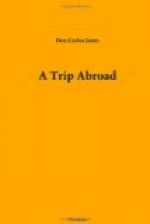There is a saying, “See Naples and die,” but I did not feel like expiring when I beheld it, although it is very beautifully located. The ruins of Pompeii, a few miles distant, had more interest for me than Naples. I went out there on the tenth of September, which I recollect as a very hot day. Pompeii, a kind of a summer resort for the Roman aristocracy, was founded 600 B.C. and destroyed by an eruption of Mt. Vesuvius in A.D. 79. It was covered with ashes from the volcano, and part of the population perished. The site of the city was lost, but was found after the lapse of centuries and the Italian Government began the excavations in 1860. Some of the old stone-paved streets, showing the ruts made by chariot wheels that ceased to roll centuries ago, have been laid bare. Portions of the houses are still standing, and the stone drinking fountains along the streets are yet to be seen, as are also the stepping stones at the crossings, which are higher than the blocks used in paving. Some of the walls still contain very clear paintings, some of which are not at all commendable, and others are positively lewd. One picture represented a wild boar, a deer, a lion, a rabbit, some birds, and a female (almost nude) playing a harp. There was also a very clear picture of a bird and some cherries. At one place in the ruins I saw a well-executed picture of a chained dog in mosaic work. It is remarkable how well preserved some things are here. In the Museum are petrified bodies in the positions they occupied when sudden and unexpected destruction was poured upon them, well nigh two thousand years ago. Some appear to have died in great agony, but one has a peaceful position. Perhaps this victim was asleep when the death angel came. I saw the petrified remains of a dog wearing a collar and lying on his back, and a child on its face. One of the men, who may have been a military officer, seemed to have a rusty sword at his side. There were skeletons, both of human beings and of brutes, bronze vessels, and such articles as cakes and eggs from the kitchens of the old city.
Mt. Vesuvius is a very famous volcano, standing four thousand feet high, and has wrought a great deal of destruction. In the eruption of 472, it is related that its ashes were carried to Constantinople; in 1066, the lava flowed down to the sea; in 1631, eighteen thousand lives were lost; and in 1794 a stream of lava more than a thousand feet wide and fifteen feet high destroyed a town. From my hotel in Naples I had a fine view of the red light rising from the volcano the evening after I visited Pompeii.




